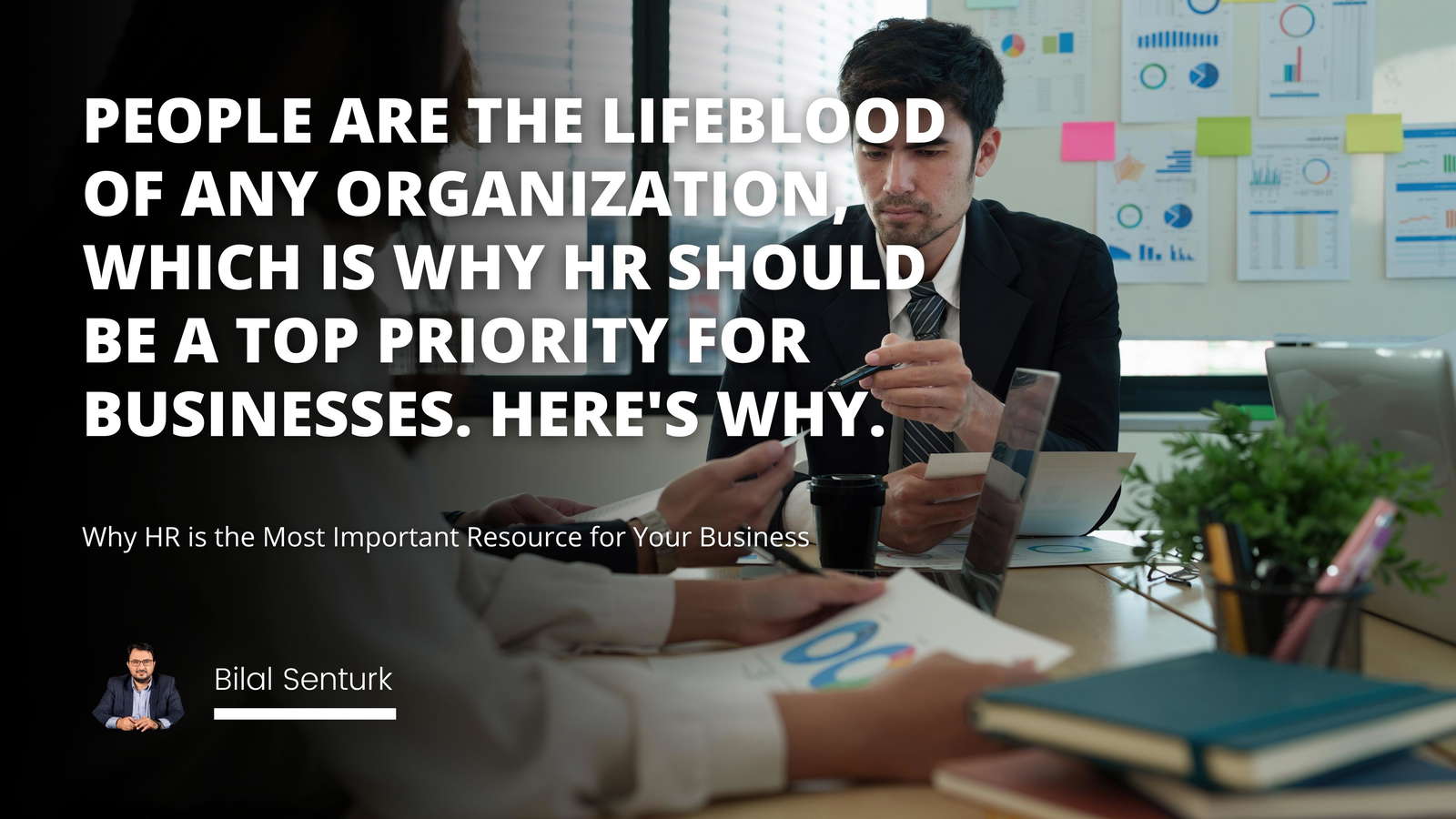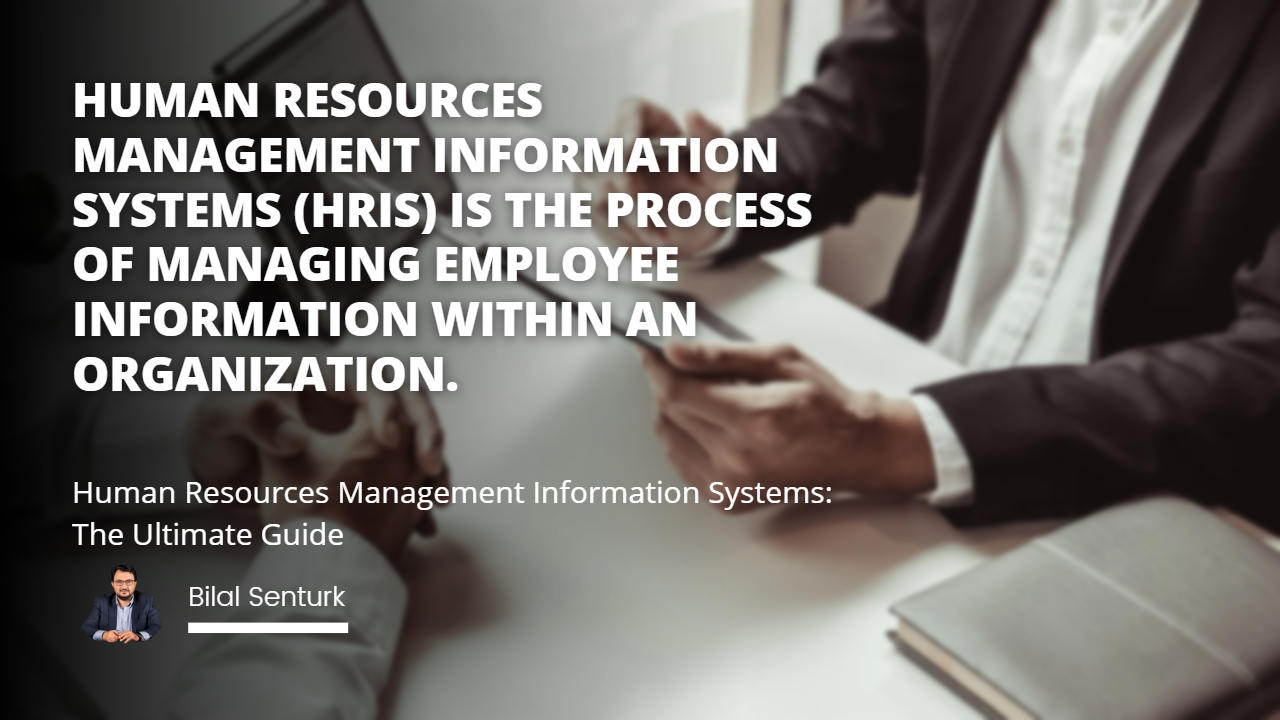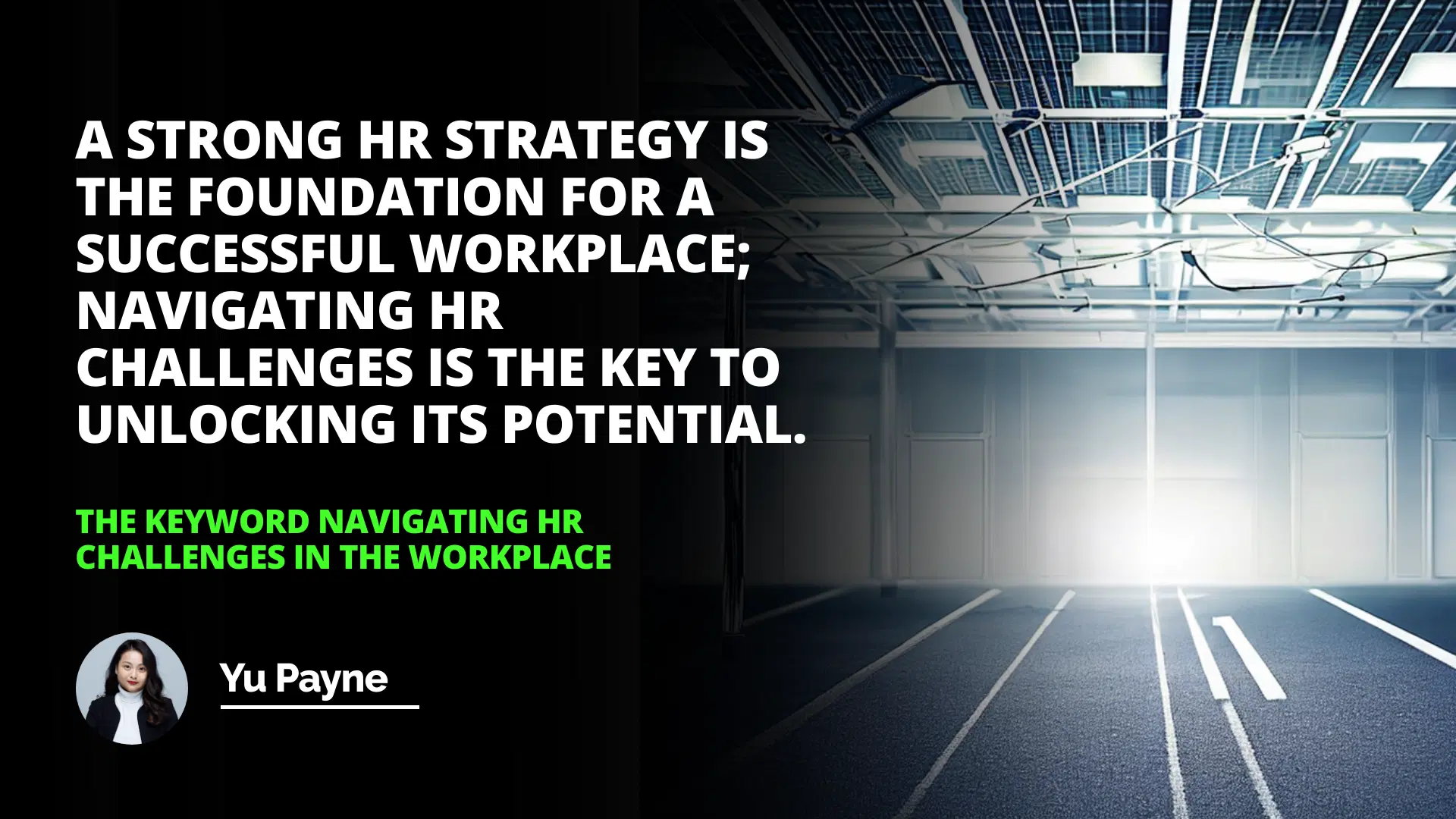
HR practitioners face various challenges in today's workplace, such as diversity, workplace illiteracy, telecommuting, and virtual management, integrating a Contingent Workforce, and work/life programs. To successfully address these challenges, HR practitioners must understand the complexities of each issue and develop strategies to ensure an inclusive workplace environment that respects and values all employees. This may involve providing training and support, developing policies and procedures, and creating programs tailored to the workforce's needs. By doing so, HR practitioners can create a successful and productive workplace.
Introduction
Diversity in the Workplace
Workplace Illiteracy
Telecommuting and Virtual Management
Integrating a Contingent Workforce and Work/Life Programs
Diversity, workplace illiteracy, telecommuting, virtual management, integrating a contingent workforce, and work/life programs are all critical challenges facing HR practitioners in today’s workplace. To successfully address these challenges, HR practitioners must be prepared to navigate the complexities of each issue.
Diversity in the Workplace
Diversity in the workplace is a complex challenge for HR practitioners. It involves understanding and respecting the different cultures, beliefs, and values of employees. To create an inclusive environment, HR practitioners must ensure that everyone feels respected and valued. This may involve implementing diversity training and developing policies that promote inclusivity.
Workplace Illiteracy
Workplace illiteracy is a challenge that HR practitioners must also address. This refers to the lack of knowledge and skills among employees in the workplace. To address this issue, HR practitioners must provide training and support to employees who lack the necessary knowledge and skills. This may involve providing on-the-job training, developing mentoring programs, and creating an environment where employees feel comfortable asking questions.
Telecommuting and Virtual Management
Telecommuting and virtual management are becoming increasingly popular in the workplace. HR practitioners must be prepared to manage employees who are working remotely and to ensure that they are productive and engaged. This may involve developing policies and procedures for managing telecommuters, providing support and resources for remote workers, and creating a virtual workplace culture.
Integrating a Contingent Workforce and Work/Life Programs
Integrating a contingent workforce and creating work/life programs is also a significant challenge for HR practitioners. This involves understanding these workers' different needs and creating programs tailored to their needs. This may involve developing flexible work schedules, offering telecommuting options, and providing support for family and personal issues.
In conclusion, HR practitioners are facing a variety of challenges in the workplace. They must be prepared to navigate these challenges to ensure a successful and productive workplace. By understanding the complexities of each issue, HR practitioners can create an environment where everyone feels valued and respected and where employees are equipped with the knowledge and skills to succeed.
A strong HR strategy is a foundation for a successful workplace; navigating HR challenges is the key to unlocking its potential.
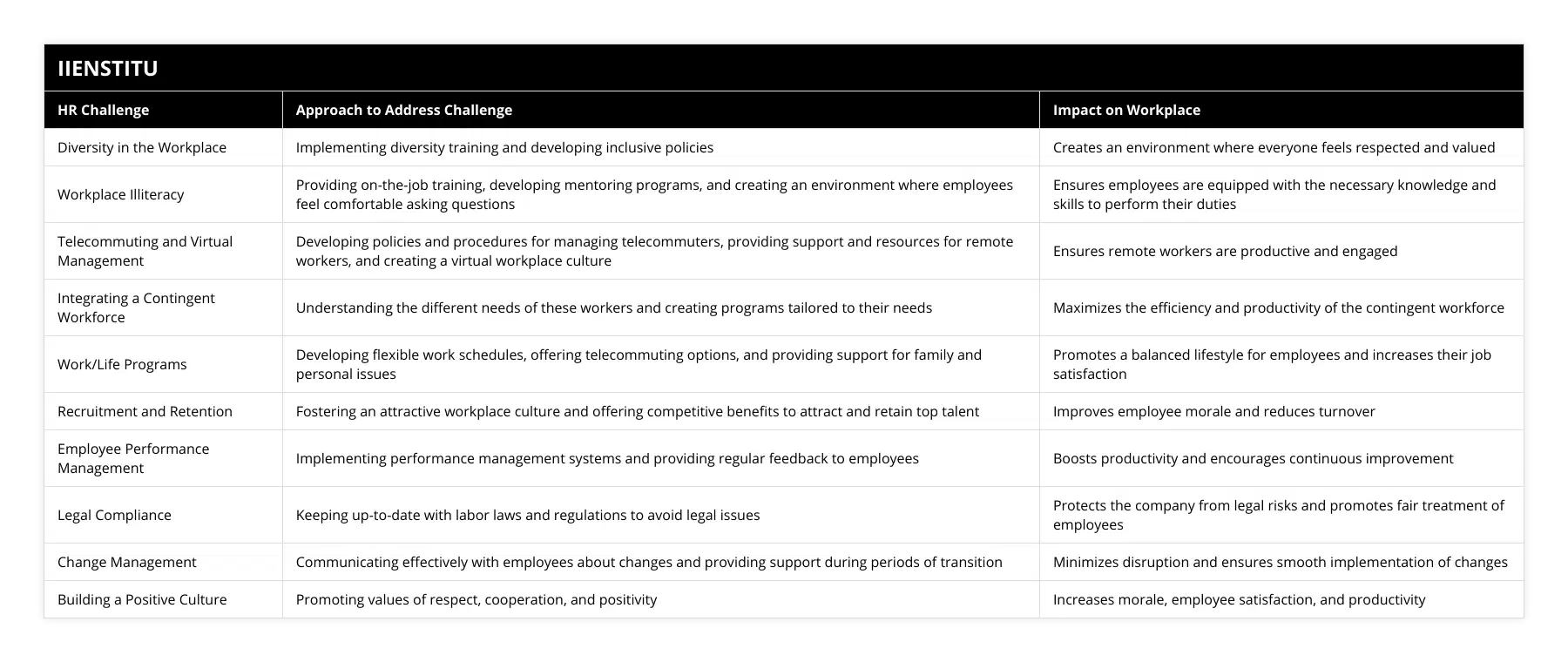
Frequently Asked Questions
What are the key factors that contribute to climate change?
Key Factors Contributing to Climate Change
There are several key factors that contribute significantly to climate change. The most significant is the burning of fossil fuels such as coal, oil and natural gas. When fossil fuels are burned, they release greenhouse gases like carbon dioxide and methane into the atmosphere. These greenhouse gases trap heat from the sun, causing global temperatures to rise.
Deforestation is another major factor. Trees absorb and store carbon dioxide. When forests are cleared, that stored carbon is released. Deforestation also reduces the number of trees available to remove carbon dioxide from the air. Between 2015 and 2020, the world lost over 4 million hectares of forest per year.
Intensive livestock farming generates significant greenhouse gas emissions. Cows and sheep produce methane as part of their digestive process. Large scale cattle ranching leads to deforestation too. The livestock sector accounts for around 15% of global emissions.
Other contributors are fertilizers containing nitrogen and the burning of biomass. Overall, human activities are responsible for almost all of the increase in greenhouse gases over the last century. To mitigate climate change, we must transition from fossil fuels to renewable energy and prevent further deforestation. We must also reduce emissions from agriculture and other sources.
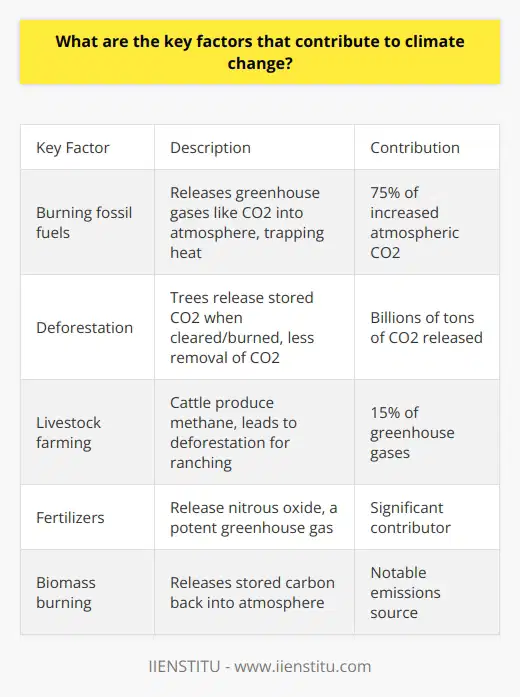
How does gender inequality manifest in different cultures?
Manifestations of Gender Inequality
Gender inequality refers to unequal treatment or perceptions of individuals based on their gender. This manifests in various ways across cultures. In many cultures, traditional gender roles cast women as caregivers and men as leaders. This leads to inequalities in domestic duties, employment, and positions of authority. For example, in parts of South Asia, women spend much more time on unpaid domestic work than men. In Saudi Arabia, strict laws prohibit women from traveling or working without a male guardian's permission.
Gender discrimination in education also perpetuates inequality. In Afghanistan, girls face barriers to attending school including lack of facilities, child marriage, and Taliban restrictions. Only 37% of Afghan girls complete primary education, compared to 66% of boys. This lack of education limits women's ability to participate in society.
Violence against women is another manifestation of gender inequality. Practices like female genital mutilation in parts of Africa, acid attacks in Southeast Asia, and honor killings in the Middle East target and control women. Up to 38% of murders of women worldwide are committed by intimate partners. Laws and enforcement often fail to protect women.
While many cultures have embedded gender inequalities, increased education for women and girls, activism, and legal protections are working to promote equal rights. Achieving gender equality requires changing long-held biases and practices.
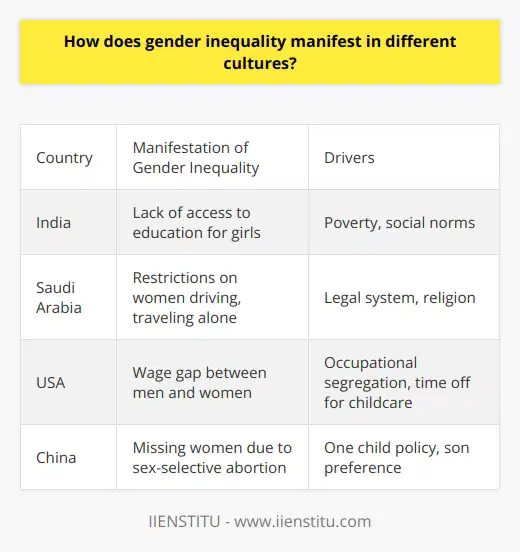
What policies can governments implement to reduce poverty?
Policies to Reduce Poverty
Governments can implement several policies to help reduce poverty. One important policy is to increase access to education. Governments can make primary and secondary education free and compulsory. They can also provide subsidies and scholarships to help low-income students attend college or vocational schools. Education gives people the skills needed to obtain better-paying jobs.
Another policy is to create more jobs and improve wages. Governments can invest in infrastructure and green technology to create construction and manufacturing jobs. They can set higher minimum wages and strengthen unions to improve pay. Policies that support small businesses can also lead to more job creation.
Governments can also strengthen social safety net programs. They can provide cash assistance, food stamps, and housing vouchers to help families meet their basic needs. Healthcare subsidies can make insurance more affordable. Increasing funding for childcare, disability, and unemployment benefits further aids those struggling financially.
Lastly, governments can reform tax policies to ease the burden on lower-income households. They can make tax systems more progressive by increasing taxes on the wealthy. Tax credits like the Earned Income Tax Credit can supplement wages for workers. Reducing regressive payroll and sales taxes helps increase take-home pay.
Implementing a mix of education, job creation, safety net, and tax reform policies can significantly reduce poverty. A comprehensive approach addresses both the symptoms and root causes of financial hardship for low-income families and individuals.
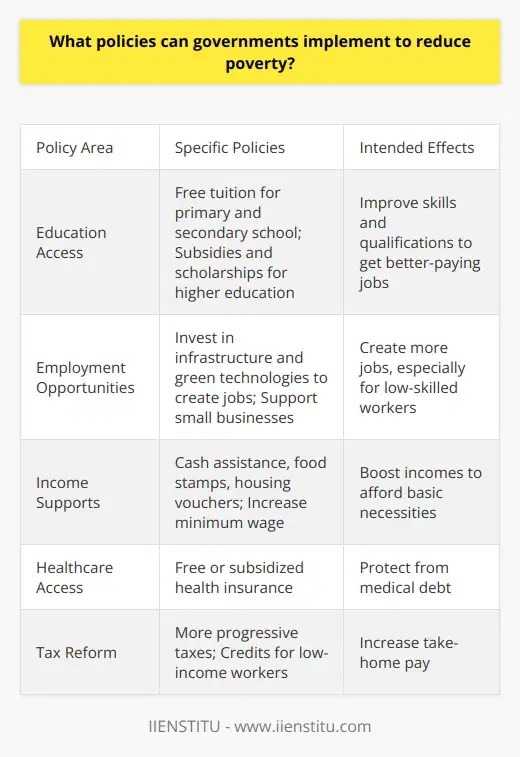
What are some of the key challenges faced by human resource managers today?
Attracting and retaining talentOne of the biggest challenges for human resource managers is attracting and retaining top talent, especially as unemployment rates decline and the labor market becomes more competitive. HR managers need to find creative ways to recruit the best candidates, through building strong employment brands, leveraging social media, and developing referral programs. Once great employees are hired, HR must focus on engagement, development, compensation and culture to retain them.
Developing leadersWith baby boomers retiring in large numbers, organizations are facing a leadership gap. HR plays a key role in identifying and developing the next generation of leaders through succession planning, leadership training, job rotations, coaching and mentoring. HR needs to assess the organization's current and future leadership needs and create programs to build leadership competencies across all levels.
Fostering a diverse and inclusive culture HR managers need to promote diversity and inclusion, given shifting demographics and the proven benefits of diverse teams. HR can drive diversity through recruiting, hiring and promotion practices. Inclusion requires training to mitigate unconscious bias, ensuring equal access to opportunities, and building a culture where all employees feel welcomed and valued.
Leveraging technologyHR managers need to keep pace with software innovations that help attract, engage, develop and retain employees. This includes applicant tracking systems, onboarding/learning management systems, employee self-service portals, and analytics dashboards. While technology improves efficiency, HR must ensure it complements rather than replaces the human touch. Data security is also a major concern.
Compliance challengesHR ensures the organization follows employment laws and regulations, which are complex and vary across locations. HR needs to stay current on legislation and case law in areas like discrimination, harassment, leaves, hiring, wages, and safety. Compliance training and auditing processes are essential to avoid lawsuits and fines.
In summary, human resource management today faces challenges in competing for talent, developing leaders, fostering diversity, leveraging technology, and managing compliance. While demanding, these challenges create opportunities for HR to strengthen organizations for the future.
What strategies can HR managers adopt to deal with the challenge of retaining talented employees?
Strategies for Retaining Talented Employees
Human resource (HR) managers face the ongoing challenge of retaining talented employees. High turnover of top talent can negatively impact organizational performance and productivity. HR managers can adopt several strategies to improve retention of star employees. This paragraph will discuss three key approaches: offering competitive compensation and benefits, providing development opportunities, and fostering an engaging work culture.
Offering Competitive Compensation and Benefits
One strategy for HR managers is to ensure compensation and benefits are competitive within their industry. Talented employees have many employment options and are attracted to organizations that compensate fairly based on skills and experience. Competitive pay demonstrates an organization values its people. Compensation should be benchmarked regularly against industry standards. Benefits like healthcare, retirement plans and paid time off should also meet or exceed norms.
Providing Development Opportunities
Another retention strategy is enabling career development through training, mentoring and stretch assignments. Talented employees are eager to continuously gain new skills. HR managers can show commitment to development through onboarding programs, skills training, and leadership development. Coaching and mentoring programs also promote growth. Project leadership roles stretch capabilities. A learning culture engages top talent.
Fostering an Engaging Work Culture
HR managers should also focus on fostering an engaging, supportive work culture. Things like clear vision/purpose, collaborative teams, empowering leadership and work-life balance attract and retain talent. HR can promote engagement through transparent communication, employee input opportunities, recognition programs, and diversity/inclusion initiatives. An engaging culture makes employees feel valued and motivated.
In summary, HR managers can retain talented employees through competitive rewards, development opportunities and an engaging work culture. Investing in top talent retention has significant benefits for organizational performance.
How can organizations create an inclusive culture that values diversity and meets the needs of a multigenerational workforce?
Fostering Inclusion Across Generations
Organizations can create an inclusive culture that values diversity and accommodates a multigenerational workforce through several key strategies. First, they must understand the unique needs, values, and communication styles of each generation, including Traditionalists, Baby Boomers, Generation X, and Millennials. With this knowledge, organizations can then take steps to promote inclusion, such as offering flexible work arrangements, creating employee resource groups, holding diversity training, and encouraging collaboration across generations.
Understanding Generational Differences
Each generation has distinct attributes shaped by their formative years. Traditionalists value consistency, hierarchy, and face-to-face communication. Baby Boomers are optimistic, competitive, and interested in personal fulfillment. Generation X is independent, adaptable, and values work-life balance. Millennials thrive on diversity, social responsibility, and technology. Recognizing these differences allows organizations to craft policies suited to multigenerational needs.
Promoting Inclusion
Organizations have several tools to promote inclusion of a multigenerational workforce. Offering flexible schedules, telecommuting, and job sharing appeals to generations seeking work-life balance. Employee resource groups bring together workers with common interests and can foster connections between generations. Diversity training programs raise awareness of generational stereotypes and build empathy. Team-building activities that mix generations encourage collaboration. Providing technology suited to each generation’s preferences also promotes inclusion. With these inclusive policies and practices, organizations can leverage generational diversity as an asset.
An inclusive culture that values generational diversity has significant benefits. It allows organizations to attract and retain top talent across generations. It enables the transfer of institutional knowledge from older to younger workers. Most importantly, it cultivates innovation, creativity, and productivity by bringing together workers with diverse perspectives. With intention and effort, organizations can meet the needs of today’s multigenerational workforce.
What are some of the major human resource management challenges and potential solutions?
Recruiting Top Talent<br>One major challenge for human resource managers is recruiting and retaining top talent. With unemployment low, competition for skilled employees is fierce. Solutions include improving the employer brand, offering competitive pay and benefits, emphasizing work-life balance, and streamlining the hiring process. Using social media and employee referrals to find candidates can also be effective.
Managing a Multigenerational Workforce<br> Today's workforce includes Baby Boomers, Gen Xers, and Millennials, all with different attitudes, expectations, and work styles. This can lead to conflicts and misunderstandings. Training managers on generational differences and effective communication can help. Offering flexibility and varied benefits tailored to different generations is also key.
Providing Effective Training and Development<br>With rapidly changing technology, ongoing training is essential for employees to maintain skills. However, training is often inadequate or ineffective. Solutions include needs assessments, varied delivery methods like e-learning, simulations, and mobile access, and evaluating training outcomes. Coaching and mentoring programs also promote development.
Controlling Rising Benefit Costs<br>The high cost of health insurance and other benefits puts financial pressure on organizations. Strategies to control costs include reducing coverage, raising deductibles, using private exchanges, and encouraging wellness programs. Limiting benefits for part-time or temporary workers can also help contain expenses.
Ensuring Compliance<br>HR must ensure compliance with employment laws and regulations, which is complex and ever-changing. Regular audits, training for HR staff, and software to track compliance are key. Seeking input from legal counsel when implementing policies can also help reduce compliance risk.
Leveraging HR Analytics<br> HR metrics and analytics are essential for demonstrating the value of HR. However, many organizations struggle to collect and analyze people data effectively. Investing in HR information systems, training HR staff on analytics, and collaborating with IT and data scientists can enhance analytics capabilities. Presenting data visually is also important.
How can organizations address common human resource management challenges through best practices and innovative solutions?
Recruiting and Retaining Top Talent<br>Organizations face challenges in recruiting and retaining top talent in today's competitive job market. Implementing best practices like employer branding, talent pipelines, and competitive compensation can help attract qualified candidates. Innovative solutions like using social media, employee referral programs, and diversity initiatives expand the talent pool. Clear career paths, learning opportunities, work-life balance policies, and strong company culture increase employee retention.
Developing Leaders and Succession Planning<br>Grooming current employees into future leaders through leadership training and stretch assignments is key for succession planning. Mentorship programs, job rotations, and high-potential development tracks build a robust leadership pipeline. Succession management software centralizes data to identify and develop successors for critical roles. Outsourcing leadership assessments adds objectivity.
Training and Development<br> Providing ongoing training and development opportunities allows employees to gain new skills and stay updated. Needs assessments identify individual and organizational gaps to target training. eLearning platforms make training accessible and self-paced. Simulations, mentoring, and stretch assignments develop capabilities. Surveys measure training effectiveness. Personal development budgets empower employee-driven development.
Engaging and Motivating Employees<br>Engaged, motivated employees are more productive and loyal. Flexible work arrangements provide work-life balance. Wellness programs support physical and mental health. Employee surveys gather feedback to improve policies. Open communication, social events, and recognition programs boost morale. Competitive compensation and benefits align rewards with performance. Clear expectations, accountability, and career growth keep employees motivated.
Promoting Inclusion and Diversity<br>Diverse and inclusive workplaces drive innovation and reflect changing demographics. Unbiased hiring practices, diversity training, mentorship programs, and employee resource groups create an inclusive culture. Flexible work options support diverse needs. Pay equity analyses ensure fair compensation. Succession plans develop diverse leaders. Tracking diversity metrics identifies gaps to guide improvement efforts. An inclusive environment engages employees and strengthens the employer brand.
What types of human resource management challenges do companies face today, and what strategies can HR professionals use to overcome them?
Human Resource Management Challenges
Human resource management today faces various challenges that make it difficult for companies to attract and retain top talent. Some key challenges include skills gaps, workplace diversity, employee engagement, and compliance with regulations. As baby boomers retire, many companies struggle to find workers with the right skills to fill open positions. Workplaces have also become more diverse, with multiple generations and cultural backgrounds working together. This diversity brings great value but also communication and relationship challenges. With the rise of remote work and constant connectivity, many employees struggle with work-life balance and burnout, hurting engagement. Additionally, HR must ensure compliance with complex regulations on issues like harassment, leave, and equity.
HR Strategies to Overcome Challenges
HR professionals can implement various strategies to address these challenges. To close skills gaps, they can focus on training, upskilling, and reskilling current employees. They can also partner with educational institutions on developing talent pipelines. To improve workplace diversity, HR can provide bias training, mentorship programs, employee resource groups, and diversity initiatives. For engagement, flexible schedules, remote work options, wellness programs, and feedback channels help employees feel valued. HR should also regularly survey engagement and make improvements accordingly. For compliance, HR must stay current on regulations and implement required policies and training. Audits help ensure ongoing adherence.
In summary, human resource management today faces challenges with skills gaps, diversity, engagement, and compliance. By focusing on training, inclusion initiatives, flexible policies, and regulatory knowledge, HR professionals can develop strategies to overcome these obstacles and create an effective workforce. The key is adapting HR practices to the changing needs of today's talent. With the right strategies, companies can attract, motivate, and retain skilled employees even with ongoing challenges.
How to overcome HR challenges
Recruiting Top Talent
Retaining Valued Employees
Developing Strong Leaders
Fostering an Inclusive Culture
Managing Organizational Change
What are some strategies for overcoming HR challenges
Recruiting and Retaining Top TalentRecruiting and retaining top talent is a major HR challenge. To overcome this, companies can focus on employer branding to build an attractive reputation and culture. They can also use social media and digital platforms to reach wider candidate pools. Offering competitive compensation and benefits is key, as is providing opportunities for career development and work-life balance. Onboarding programs help new hires feel welcomed and engaged.
Developing LeadersLeadership development is vital for organizational success. HR can provide training and coaching to nurture leaders at all levels. Programs like mentorship, job rotations, and stretch assignments give hands-on leadership experience. Assessing leadership potential during the hiring process helps too. Ongoing 360 reviews and feedback help leaders improve. Succession planning ensures continuity of leadership.
Fostering an Inclusive Culture Promoting diversity, equity and inclusion is an HR priority. Strategies include educating on unconscious bias, implementing inclusive policies, setting diversity goals, and supporting employee resource groups. Training managers to foster inclusivity is key. Analyzing pay equity and hiring practices prevents discrimination. Flexible work arrangements support diverse needs. Surveying employees on feelings of inclusion provides insight.
Managing ChangeOrganizational change inevitably causes uncertainty. HR can ease the transition by communicating transparently, providing training, and giving employees a voice. Soliciting input shows change is a team effort. Transition teams help guide the process. Coaching leaders on change management is important. Recognizing accomplishments along the way motivates. Listening to concerns and providing support empowers employees.
Developing Agile CultureToday's volatile environment requires organizational agility. HR helps by upskilling workers for new roles, supporting cross-functional collaboration, and enabling knowledge sharing. Surveying staff and using feedback loops inform agile ways of working. Self-organizing teams empower employees to adapt. Iterative goal setting, rather than rigid annual plans, allows for flexibility. Investment in digital tools and new skills enables responsiveness.
What can HR professionals do to overcome common challenges in human resources management?
Recruiting and Retaining Top Talent<br>HR professionals face the ongoing challenge of recruiting and retaining top talent. To overcome this, they can focus their efforts on employer branding to attract candidates, offer competitive compensation and benefits, create engaging and supportive company cultures, provide opportunities for growth and development, and leverage technology to streamline recruiting and onboarding processes. Taking a strategic approach to talent acquisition and management will help secure the human capital organizations need to succeed.
Managing Workplace Diversity<br> Many organizations struggle with effectively managing a diverse workforce. HR can promote inclusion by reviewing hiring practices to reduce bias, offering diversity training, encouraging open communication, fostering cultural awareness, and holding all employees accountable for respectful conduct. Implementing mentorship and employee resource groups also helps engage diverse workers. When diversity is well managed, it leads to greater innovation, productivity, and competitiveness.
Developing Leaders and Facilitating Succession Planning<br> HR plays a key role in developing internal talent pipelines. They can identify high-potential employees through performance reviews and create leadership development programs. Coaching, stretch assignments, and mentoring help strengthen next-generation leaders. HR should collaborate with department heads on succession plans to ensure continuity when key personnel depart. Investing time and resources into leadership development is vital for organizational growth and sustainability.
Compliance with Laws and Regulations<br>Staying current on employment laws and regulations is an ongoing struggle, as legal frameworks frequently evolve. HR professionals must make compliance a top priority by closely tracking updates, auditing policies and handbooks, documenting processes, and training managers on lawful practices. They can leverage technology and outside legal counsel to help monitor compliance. Adhering to legal and ethical standards reduces litigation risks and creates a fair, safe workplace.
Adapting Policies and Practices to Meet Changing Needs<br>HR departments often lag in updating their programs and processes to align with changing workplace dynamics. To overcome this, they can actively survey employees on their needs, benchmark competitor practices, and pilot innovative initiatives. Areas like remote work, flexible scheduling, family leave, and learning require new approaches. By regularly reviewing and evolving policies, HR can help drive positive organizational change rather than reacting to it.
Leveraging HR Metrics and Analytics<br>Many HR teams struggle to demonstrate their strategic value through metrics and analytics. To overcome this, they can identify key performance indicators, gather insightful data, analyze trends, and clearly communicate results to stakeholders. Leveraging analytics helps refine programs, reduce costs, predict challenges, and improve the employee experience. When HR can quantify its impact, it elevates its role as a strategic business partner.
What are some of the challenges in human resource management today?
Recruiting and Retaining TalentOne of the biggest challenges for human resource managers today is recruiting and retaining top talent. With unemployment rates low, there is more competition for skilled employees. HR managers need creative recruiting tactics to find qualified candidates. Once hired, engaging employees and providing opportunities for growth and development are key to retention. Building an attractive company culture and strong employer brand can also help attract and keep talented workers.
Managing a Multigenerational Workforce Today's workforce includes Baby Boomers, Gen Xers, Millennials, and Gen Zers. Each generation has different expectations, attitudes, and work styles. Managing a multigenerational workforce requires understanding these differences and bringing out the strengths of each generation. HR must implement policies, training, and incentives that appeal to all generations. Effective communication, flexibility, and respect for diversity are essential.
Adapting to Changing Technology HR teams must keep pace with rapidly evolving workplace technology. Cloud computing, automation, artificial intelligence, and new collaboration tools are transforming how work gets done. HR professionals need to understand these technologies and how they impact recruiting, training, performance management, and other HR functions. Adopting the right tech tools while building human skills is crucial.
Data Analysis and MetricsWith vast amounts of employee data available, HR teams are increasingly using analytics for data-driven decision making. Metrics help track recruiting success, retention rates, training needs, and talent pipeline health. While analytics provide valuable insights, HR must use care in collecting and interpreting data to avoid biased decisions. Balancing data with human judgment is key.
Compliance and Legal ChallengesHR managers must keep up with complex and frequently changing labor laws related to hiring, pay, benefits, discrimination, safety, and more. Lawsuits over harassment, diversity, wage rules, and leave policies are common. HR helps organizations mitigate legal risks through policies, training, documentation, and by seeking legal counsel when needed. Staying current on regulations is a constant challenge.
Developing HR's Strategic Role Rather than just handling administrative tasks, HR is increasingly seen as a strategic partner. To provide maximum value, HR teams must align their goals with overall business objectives. HR professionals need strong business acumen and data analysis skills to provide workforce analytics and input on strategic planning. Upskilling HR staff and educating executives on HR's strategic importance are key steps.
How can organizations overcome the challenges in human resource management?
Recruiting and Retaining TalentOrganizations face challenges in recruiting and retaining top talent. To overcome this, they can focus on employer branding to build their reputation, offer competitive compensation and benefits, promote a positive work culture, provide opportunities for growth and development, and leverage technology to improve the recruiting process. Strong employer brands attract qualified candidates. Competitive pay and benefits encourage employees to join and stay. Supportive cultures where people feel valued and able to thrive keep engagement high. Development opportunities show potential for advancement. Using AI and data analytics in recruiting helps find and engage suitable candidates faster.
Training and DevelopmentEffective training and development is essential for organizational success, yet often overlooked. Organizations can prioritize workplace learning to upskill employees and prepare them for the future. Onboarding, mentorship, and continued education through internal and external training build capabilities. Needs assessments identify skills gaps to target development areas. Blended learning combines online and in-person methods for flexibility. Leadership programs groom managers. Job rotations provide cross-functional experience. Coaching and feedback foster growth. Succession planning readies leaders in the pipeline. Investing in people boosts engagement, innovation, and performance.
Engagement and Culture Lack of employee engagement hurts productivity and retention. Organizations must nurture positive workplace cultures to keep people motivated. Leaders should role model desired behaviors and communicate a compelling vision and values. Recognizing achievements, encouraging collaboration, and empowering people to take ownership of work builds engagement. Flexible policies support work-life balance. Diversity, equity and inclusion efforts create welcoming environments. Surveying employees regularly uncovers issues to address. Open communication, transparency from leadership, and acting on feedback are critical. Cultivating cultures where people feel appreciated, challenged, supported, and heard enhances morale.
Performance ManagementThe traditional annual review process is often ineffective. Organizations can rethink performance management to drive productivity. Setting clear goals and expectations, providing regular feedback, and coaching help align individual objectives with organizational strategy. Data-driven analytics track progress and inform development areas. Continuous performance conversations replace annual reviews. Peer feedback adds perspective. Rewards and incentives link to key results, not tenure. Customizable frameworks accommodate diverse roles. Self-evaluations encourage employee ownership. Well-designed performance management that focuses on enabling people to succeed boosts engagement and capability.
Leveraging HR Technology Outdated and disjointed HR systems create inefficiencies. Organizations can implement integrated HR technology platforms to optimize operations. Core HRIS provides a single database for all employee information. Applicant tracking simplifies recruiting and hiring. Learning management facilitates training and development. Talent management includes performance, goals, and succession planning. Business intelligence offers data analytics for insights. Cloud-based systems increase accessibility and mobility. Automation handles high-volume administrative tasks. Seamless integration between modules improves the user experience. Keeping current with the latest HR technology allows organizations to manage the workforce more effectively in today's digital world.
What strategies can be implemented to address the challenges in human resource management?
Recruiting and Retaining TalentAn ongoing challenge for human resource managers is recruiting and retaining top talent. With unemployment rates low, competition for skilled employees is high. Organizations can improve recruiting by enhancing their employer brand and emphasizing the positives of working for the company. Offering competitive compensation and benefits is key, as is creating an engaging workplace culture where employees feel valued. Effective onboarding, training, and development opportunities also help retain talent. Managers should check in regularly with employees about job satisfaction and career goals. Flexible work arrangements may also boost retention.
Managing a Multigenerational WorkforceToday's workforce spans multiple generations, each with different attitudes, expectations, and work styles. This diversity can lead to conflicts and miscommunication. Training managers on generational differences and inclusive leadership helps. Offering flexibility is also key - options like telecommuting, varied shifts, and job sharing appeal to older workers seeking work-life balance as well as younger employees who value autonomy. Recognizing employees for their contributions, regardless of age, is important. Facilitating mentorship across generations can foster mutual understanding.
Adapting to Changing Technology HR managers must keep pace with rapidly evolving workplace technology, from AI to automation. Providing training helps employees adapt to new tech tools and processes. HR should also leverage technology - applicant tracking systems, online onboarding, e-learning platforms, etc. - to enhance efficiency and analyze data to inform decisions. However, over-reliance on technology can degrade workplace culture and employee engagement. HR should ensure a human touch through coaching, community-building initiatives, and two-way communication channels.
Compliance ChallengesHR must ensure organizational compliance with employment laws and regulations, which are complex and evolving. Regular audits help identify problem areas. Ongoing training on legal requirements makes managers and employees more aware. Seeking input from legal counsel reduces compliance risks. HR should also leverage technology like HRIS systems to help track compliance tasks and deadlines. However, over-emphasis on compliance can result in rigid policies that negatively impact workplace culture and employee morale. HR leaders must find a balance, being diligent about compliance while still building an engaging employee experience.
How to handle HR issues at work
Communicate Issues RespectfullyWhen HR issues arise at work, it is important to communicate about them in a respectful manner. Bring up concerns calmly and professionally, using non-accusatory language. Focus the discussion on finding solutions rather than blaming others. Listen carefully when others speak to understand all perspectives on the issue. Show empathy and keep an open mind.
Follow Proper ProceduresMost companies have established procedures for reporting HR grievances. Familiarize yourself with these policies and follow them accordingly. For example, many organizations want employees to first address issues directly with their manager before escalating to HR. Going through proper channels shows respect for the company and helps facilitate effective resolution.
Document Interactions Keep records of any inappropriate behaviors, policy violations, or HR incidents. Note specifics like dates, times, locations, witnesses, and exact words used. Documentation creates a paper trail should further action be necessary. However, avoid secretly recording conversations without the other person's consent, as that may be illegal.
Involve HR When NeededWhile minor issues may be resolved directly between colleagues, HR should be brought in for more egregious or persistent matters. Discrimination, harassment, safety concerns, violence, and retaliation are all issues that warrant HR involvement. HR can investigate complaints impartially and has greater authority to reprimand or terminate problematic employees.
Protect Confidentiality When reporting sensitive HR issues, insist that details be kept confidential to the extent possible. Information should only be disclosed on a need-to-know basis with those involved in the resolution process. Unnecessary gossip about personnel issues can damage workplace morale and trust. However, be aware that total anonymity may not be feasible if your report leads to disciplinary action.
Avoid RetaliationRetaliating against an employee for lodging an HR complaint is illegal. If you experience any form of retaliation for reporting an issue, document the incidents and notify HR immediately. Examples of retaliation can include demotion, discipline, termination, or sudden undesirable assignment changes. Speak up right away if you feel you are being punished for coming forward.
Participate in Good Faith Cooperate fully and honestly with any HR investigations into issues you helped raise. Provide all relevant details about the matter, but avoid exaggeration or embellishment. Correct any factual inaccuracies you may have reported initially. Adopt a constructive mindset focused on enhancing workplace culture rather than attacking others.
Seek Outside Help if NeededIf HR fails to adequately address your complaints, consider contacting an external agency such as the Equal Employment Opportunity Commission. Severe or pervasive issues may require intervention from legal authorities. However, external escalation should be a last resort after exhausting all internal resolution options.
What are some effective strategies for dealing with difficult HR situations
Communicate ClearlyWhen dealing with difficult HR situations, it is important to communicate clearly with all involved parties. Be direct yet compassionate when discussing issues. Provide clear explanations for any decisions made and give opportunities for employees to respond. Using simple, straightforward language avoids miscommunications. Summarize conversations in writing to ensure mutual understanding.
Remain Objective Difficult situations often involve strong emotions. However, HR professionals must remain objective to make fair, ethical decisions. Focus on facts and policies rather than personalities when investigating issues. Avoid accusatory language and jumping to conclusions. Document details thoroughly. Making decisions based on reason rather than emotion or bias leads to better outcomes.
Listen ActivelyGive employees involved in disputes ample opportunity to explain their perspective. Ask open-ended questions and reflect back key points to show active listening. Seek to understand all sides before rendering judgement. Listening demonstrates respect and helps uncover subtleties that written statements may miss. Ensure all parties feel heard before deciding on a resolution.
Act DecisivelyOnce an investigation into an issue is complete, act decisively to resolve the situation. Quickly making and implementing decisions prevents problems from escalating. Communicate decisions promptly and directly. Follow disciplinary procedures consistently to avoid claims of unfairness. Uphold policies and contractual agreements to maintain credibility. Move forward after decisions rather than rehashing issues.
Maintain ConfidentialityRespect the privacy of employees involved in difficult situations by maintaining confidentiality. Only disclose sensitive information to those directly involved in resolving issues. Remind employees under investigation not to discuss cases. Refrain from gossip and reveal details only on a need-to-know basis. Breaches of confidentiality can worsen conflict and erode trust in HR. Handle matters discreetly to protect reputations.
Provide Support In addition to addressing root causes of problems, also provide support to help employees through challenges. Offer counseling or coaching to improve behavior or performance issues. After conflicts, promote healing through mediation and team-building activities. Provide training and instruction to prevent future incidents. Support employees while upholding policies and obligations. A compassionate approach eases tensions and improves workplace culture.
What steps can be taken to resolve conflicts with HR while maintaining a professional relationship?
Steps to Resolve Conflicts with HR Professionally
When conflicts arise with human resources staff, it is crucial to address issues professionally to maintain working relationships. First, clearly communicate concerns through proper channels. Schedule a meeting to discuss problems directly with the HR representative involved. Use "I" statements to explain how situations affect you without blaming. Listen respectfully to the HR representative's perspective, asking clarifying questions. Acknowledge valid points and find common ground. Brainstorm mutually agreeable solutions. Follow up in writing to document the discussion and agreed actions.
Second, focus discussions on resolving conflicts, not attacking character. Avoid heated arguments or emotional outbursts which can damage working relationships. Be specific about issues but do not make generalizations about HR competency. Provide concrete examples to illustrate concerns while maintaining composure. Seek to understand rather than condemn. Find shared interests like improving policies and procedures.
Third, involve other stakeholders like managers only if necessary. Rely on formal grievance procedures sparingly as a last resort. Keep discussions between parties directly involved whenever possible. Looping in additional people can embarrass the HR representative and escalate tensions. The goal should be reaching understanding through open communication, not punishment.
Fourth, align demands with business objectives. Frame requests in terms of how solutions will improve operations, productivity, or morale. Connect issues to strategic goals and data on business impact. This shows conflicts are not personal but aimed at better serving the organization. Offer realistic suggestions focused on positive progress.
Fifth, compromise and be willing to accept partial solutions. Insisting on total capitulation to demands generally backfires, straining working relationships further. Have flexibility on remedial actions and timelines. Meet in the middle instead of staking out rigid stances. Build trust through incremental progress and consistency in following through.
With professional communication, empathy, and flexibility, many conflicts with HR staff can be resolved while maintaining effective working relationships. The focus should be on understanding different perspectives, finding common ground, and making gradual improvements over time. With good faith efforts, cooperation can replace counterproductive antagonism.
What are some of the key challenges faced in strategic human resource management?
Some of the key challenges faced in strategic human resource management include aligning HR strategy with business strategy, managing change and transitions, developing talent, and leveraging technology.
Aligning HR and Business Strategy
One major challenge is ensuring the HR strategy supports and aligns with the overall business strategy. HR leaders need to understand the company's goals and direction in order to develop HR initiatives that drive those strategic objectives. However, business strategies can change rapidly, so HR must be agile and adaptable in response. Ongoing communication between HR and business leaders is critical.
Managing Change
HR plays a central role in managing organizational change, such as restructures, downsizing, mergers and acquisitions. Change management entails communicating to employees, providing training and resources, and supporting employees through transitions. Resistance to change and loss of productivity are risks that HR must mitigate through thoughtful change management.
Developing Talent
A key HR challenge is developing talent to meet current and future business needs. This requires forecasting talent needs, establishing development programs, and creating retention strategies. Building a robust talent pipeline is crucial for organizational success. Lack of critical skills and knowledge gaps are talent challenges HR must address.
Leveraging Technology
HR needs to leverage technology to improve efficiency and deliver data-driven insights. However, adopting new HR information systems, analytics tools, and AI can be complex and expensive. Change management is also needed to gain employee adoption. Still, effectively leveraging HR technology is essential to enhancing the function's strategic value.
In summary, strategic HR management faces challenges in alignment, change management, talent development, and technology. By proactively addressing these challenges, HR can become a more strategic partner in driving business success.
How can organizations effectively align their HR strategies with overall business strategy?
Aligning HR and Business Strategy
Organizations can effectively align their human resource (HR) strategies with overall business strategy in several key ways. First, HR leaders need a seat at the table when business strategy is developed. This ensures HR is aware of strategic goals and can develop supportive initiatives. Second, organizations should conduct workforce planning to anticipate future talent needs based on business plans. Workforce analytics can identify current capabilities versus future requirements. Third, recruitment, development, and retention programs should align to strategic capabilities. HR should source, train, and motivate the talent needed for strategy execution.
Additionally, performance management and rewards should reinforce behaviors that drive strategic success. Competencies, goals, and incentives should connect employees with strategy. Furthermore, organizational culture and leadership should promote strategic focus. HR can foster a culture that supports the business strategy through communications, training, and modeling desired behaviors. Finally, HR should regularly assess the effectiveness of HR practices in enabling business strategy and make improvements as needed. Overall alignment requires collaboration between HR and business leaders, data-driven workforce planning, and intentional talent management focused on strategic capability development.
In summary, organizations can align HR and business strategy by involving HR in strategy formulation, conducting workforce analytics, aligning talent programs to strategy, reinforcing strategy via performance management, promoting a strategic culture, and regularly reviewing and improving HR-strategy alignment. With increased globalization and pace of change, this alignment is more critical than ever for organizational success. HR has a key role to play in enabling the execution of business strategy.
What skills and capabilities are required for HR professionals to become strategic partners?.
Skills and Capabilities for HR as Strategic Partners
Human resource (HR) professionals must develop a broad range of competencies to effectively transition into strategic partners who align HR strategies with overall business goals. Some key skills and capabilities required include:
Business Acumen
HR professionals need strong business acumen and understanding of core business functions like finance, operations, and marketing. This knowledge helps HR provide insights during strategic planning and decision-making. HR should view issues from a business perspective.
Analytics and Metrics
Leveraging data analytics is crucial. HR needs analytical skills to gather and interpret workforce metrics, identifying opportunities and issues. Analytics informs talent management, demonstrating HR's strategic value.
Consulting and Advisory Skills
HR should act as an advisor to senior leaders on human capital issues like succession planning, change management, and resource allocation. HR must synthesize information and provide recommendations from an organizational perspective.
Business Partnering and Relationship Building
HR needs strong partnership abilities to collaborate with business leaders across the organization. Relationship building fosters trust in HR. Partnering skills are vital to understand needs and provide consultative support.
Organizational and Industry Knowledge
HR should understand their organization's structure, functions, culture, and challenges. Insight into the competitive landscape, industry trends, and external pressures allows HR to develop aligned strategies.
Communication and Influence
Communication and persuasion skills enable HR to synthesize complex information into actionable insights for stakeholders. HR must tailor messaging and influence leaders to drive change.
Strategic Thinking
HR should adopt a future-oriented perspective, thinking critically to translate business objectives into people strategies. This involves challenging assumptions and providing solutions to achieve long-term goals.
Developing these well-rounded competencies empowers HR to provide greater strategic value as partners in organizational success.
What are some of the key challenges in human resource planning?
Forecasting Human Resource NeedsOne of the main challenges in human resource planning is accurately forecasting future human resource needs. It can be difficult to predict staffing needs far in advance due to uncertainties in the business environment. Factors like economic conditions, changes in technology, new competitors entering the market, and shifts in consumer demand can all impact workforce requirements. HR planners need robust models and techniques to estimate human capital needs despite these uncertainties.
Retaining TalentAnother major hurdle is retaining top talent within the organization. Skilled and experienced employees are valuable assets that are difficult to replace. High turnover can disrupt operations and drain HR budgets for recruitment and training. HR must implement effective retention strategies like competitive compensation, training and development opportunities, work-life balance policies, and succession planning. The war for talent makes retaining high performers an ongoing struggle.
Developing Leadership Pipeline Human resource planning also involves developing a robust leadership pipeline. As senior leaders retire, organizations need qualified managers ready to step into key roles. Lack of succession planning can leave companies with talent gaps in critical positions. HR needs to identify high-potential employees early and develop leadership competencies through training programs, job rotations, coaching, and stretch assignments. An inadequate leadership pipeline can undermine an organization's future.
Aligning HR Strategy with Business GoalsHR planning must align with the overall business strategy. If workforce plans do not support organizational objectives, then companies will likely face talent shortages in key areas. HR should collaborate with business leaders to understand strategic priorities and talent implications. Coordination between HR and line managers is vital to link workforce planning with business goals. This strategic alignment remains an ongoing process as business strategies evolve.
Leveraging HR Analytics HR analytics and metrics are essential for data-driven workforce planning. However, many HR departments lack the capabilities to leverage analytics. Building expertise in HR metrics and developing analytics models like staffing forecasts, cost projections, and return on investment analysis poses challenges. HR may need to invest in analytics systems and train staff on metrics to enhance evidence-based decision-making for strategic planning.
What factors make human resource planning difficult for organizations?
Factors Making Human Resource Planning ChallengingHuman resource planning involves forecasting an organization's future human resource needs and developing plans to meet those needs. It is an important process, but several factors make human resource planning difficult for organizations. Technological ChangesAdvances in technology are occurring rapidly, transforming how work gets done. Organizations struggle predicting which new technologies will become impactful. This technological uncertainty makes estimating future human resource needs problematic. Organizations risk over or under staffing functions impacted by unforeseen technological shifts.Dynamic Business Environments Today's business landscape evolves quickly. Markets, competitors, regulations, and financial conditions change frequently. This dynamic environment makes predicting an organization's future human resource needs difficult. Needs depend heavily on how the business environment develops, which is hard to foresee.GlobalizationGlobalization allows organizations to operate internationally. However, different countries have unique cultures, laws, talent pools, and business practices. These complex, diverse factors make planning a global workforce complicated. Organizations must understand nuances across many regions to recruit, develop, and manage human resources effectively worldwide.Evolving Skill SetsThe skills organizations need from workers are continuously evolving. Predicting which skills will become more or less important is not easy. Failing to accurately anticipate changing skill requirements results in talent shortages or surpluses. Organizations struggle hiring and training people with abilities that will be valuable in an uncertain future.In summary, human resource planning is challenging because technology, business environments, globalization, and skill sets needed are always changing. Organizations must become comfortable making plans despite uncertainty in these areas.
How can organizations address the various challenges associated with human resource planning?
Anticipating Future HR NeedsOrganizations can address challenges with human resource planning by taking steps to anticipate future HR needs. Conducting environmental scans helps assess trends that may impact workforce supply and demand. Forecasting techniques like trend analysis examine historical data to predict future HR needs. Scenario planning explores multiple possible futures to prepare for different contingencies. Regularly reviewing and updating forecasts ensures they account for changing conditions. Aligning HR Planning with Organizational Goals HR planning should align with the organization's strategic goals. HR plans that complement broader organizational objectives have greater impact. Collaboration between HR and executive leadership on strategic planning ensures alignment. HR planning processes should consider how trends like emerging technologies and globalization affect strategic goals. Coordinated planning enables HR to build capabilities that support desired strategic outcomes.Improving Data Analytics CapabilitiesReliable data analytics capabilities are crucial for effective HR planning. Organizations should invest in HR information systems that integrate and track useful metrics. Data mining techniques help uncover patterns and insights about the workforce. Predictive analytics tools assist with modeling and forecasting future scenarios. Providing analytics training and resources enables HR to fully leverage data when planning.Building a Flexible WorkforceOrganizations can pursue flexible workforce structures that adapt to changing conditions. Options like temporary employees, freelancers and outsourcing give workforce agility. Multi-skilled workers who can shift roles smooth imbalances between labor demand and supply. Flexible work arrangements like remote work widen talent pools. Investing in learning and development prepares workers to transition between roles. A flexible workforce allows HR plans to adjust amid uncertainties.Fostering Cross-Functional Collaboration HR should collaborate with other functions when planning. Finance provides useful data on budgets and costs. Operations offers insights on workflows and productivity. Marketing assesses customer needs that may influence hiring. IT alignment ensures HR systems support broader strategic technology goals. Cross-functional collaboration allows HR planning to consider all factors that impact human capital needs.
